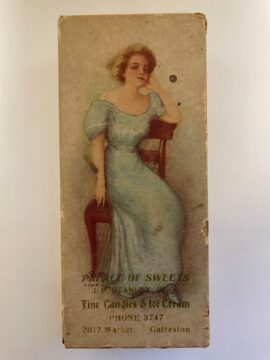Everyone knows that on Valentine’s Day, you give your Valentine a card, a box of chocolates, a bouquet of roses, or perhaps all three. But do you know the origins of these traditional gifts?
While the creation of Valentine’s Day itself dates back to the Roman Empire, the practice of giving Valentine’s gifts was popularized in the Victorian era. Victorians were very sentimental and loved to have material reminders of their loved ones, living or deceased. Personalized items like decorative candy boxes and love tokens became common gifts year-round, but especially as a special symbol of affection on Valentine’s Day.
Candy Boxes
Candy, and specifically chocolates, became associated with Valentine’s Day thanks to Richard Cadbury, owner of the highly successful British chocolate manufacturing company that is still around today. Cadbury recognized the growing popularity of Valentine’s Day and the practice of giving elaborate Valentine’s gifts and began selling his chocolates in beautifully decorated boxes to meet this increasing demand. While Cadbury produced these chocolate boxes year-round, he sold special boxes for Valentine’s Day that featured Cupids and roses. It is also believed that Cadbury was the first to produce the heart shaped boxes that are so common today.
This 1916 candy box from our collection is stamped with the name of a local store: “Palace of Sweets, J.P. Stanley Prop. Fine Candies and Ice Cream - Phone 3747 - 2017 Market Galveston.” After eating the chocolates, one could keep the decorative box to store jewelry or other trinkets.

Love Tokens
Love tokens are coins, usually silver dimes, which are hand-engraved with initials, pictures, or messages after minting. The coins were typically taken out of circulation by the engraver, and the reverse side was scraped smooth to allow room for personalized engravings.
Love tokens are believed to have originated in 13th century Britain with the practice of “bending” coins for good luck or to have a physical reminder of one’s promise or pledge to a saint. A version of the love token was common in 16th century France, where 13 specially carved coins or treizains were given to young couples getting married.
While love tokens existed for several centuries, they reached the height of their popularity in the Victorian era. Love tokens could be given to sweethearts or family members, on Valentine’s Day or any occasion. In fact, they were used to propose marriage before diamond engagement rings became popular in the 1940s. Each love token was unique, although many shared common design features such as triple-overlapping initials, usually of the giver of the token, as seen on this 1889 example from our collection. Generally, the tallest and narrowest letter is the first name, and the widest letter is the last, meaning that the initials on this token would be JHA.


The practice of giving love tokens died out after the turn of the century as paper photographs became widely available and people chose to wear lockets with photographs of their loved ones inside. But whatever the era, Valentine’s Day gifts have become a heartfelt symbol of the love we feel for the people in our lives.
The Treasure of the Month is located on the library’s historic second floor near the East Entrance. It can be viewed during regular library hours, 9:00 a.m. to 5:45 p.m. Monday through Saturday. For museum questions, call 409.763.8854 Ext. 125 or email museum@rosenberg-library.org. For press inquiries, contact the Communications Coordinator.